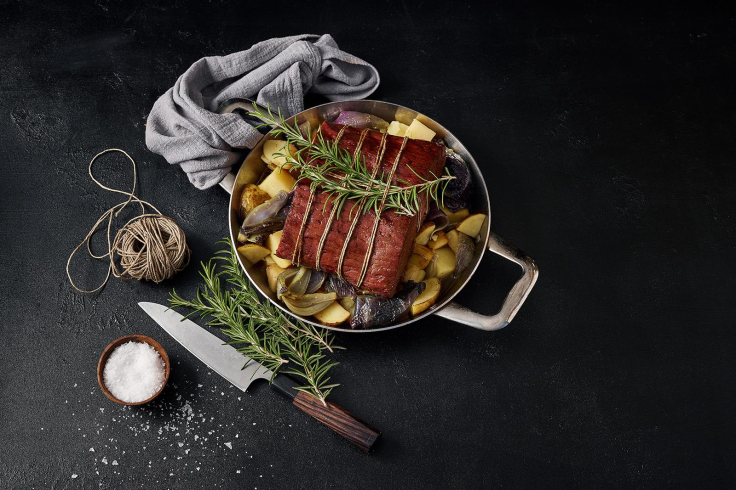
The Chinese word for pork is zhūròu ( 猪肉 ), which means – quite literally – “pig meat.” Likewise, beef is “cow meat.” The Chinese language is far from unimaginative, but when it comes to meat – what you see is what you get. English, on the other hand, has “pig/pork,” “cow/beef,” “deer/venison,” etc. Here’s a brief etymology lesson: In 1066, Duke William of Normandy successfully invaded England – becoming William the Conqueror. Normans were the descendants of Vikings who acquired French lands in exchange for ceasing the ‘raiding and pillaging’ part of their culture. –A century or so later, these ex-Vikings now spoke a type of French. When they became masters of England, their language came with them. An English peasant might have said something that translated closer to “the flesh of the swine” or “cow meat” but the Norman aristocrats used their version of French. Why then has “chicken” stayed “chicken”? Economics. Beef and pork were expensive, so more commonly consumed by Norman overloads. Eventually, the Norman words became new English words for these meats.
This language lesson is interesting, but it also underscores a fundamental truth that’s been around a long time. Some of our favorite meat animals – in particular pigs and cows – require a lot of resources as they go from birth to the dinner table. All over the world, pork (except in Jewish and Muslim cultures) and beef have been “for special occasions,” except for the affluent. In the second decade of the 21 st century, however, this isn’t necessarily the case. Billions of humans are now wealthy enough to afford beef or pork – some as a staple of nearly every meal. While this change has been welcomed by many meat-eaters, it isn’t such great news for the planet. “Sustainability” can be an irritating buzzword, but when it comes to meat consumption, it’s right on the money. Today the question isn’t “how can we make meat more affordable?” it’s “how can we afford to continue satisfying our growing, eco-resource-taxing, demand for meat?” Perhaps the answer is plant-based meat.
We can hear the dejected sighs: “What? Fake meat? Um… thanks, but I’ll pass.” And such initial reactions are understandable. Lots of folks have had a great veggie burger or a really good faux hot dog… but those things aren’t “meat.” Most people want meat. Meat tastes good. Meat is satisfying – nutritious and delicious. Meat substitutes – even the latest “fancy” ones – aren’t terrible, but to a meat-lover, they don’t bring home the bacon. Wait, however, until you try 3D printed meat – or what’s being termed “alternative-meat.” Designed by companies such as Israeli start-up Redefine Meat, this “new meat” is really a whole different animal. With the use of special 3D printers that lay down layer after layer of “alt-fat,” “alt-muscle” and other “secret” 100 percent plant-based ingredients, they are able to produce something that smells, feels, looks, tastes, has the texture of, and even “cooks” like meat. –Seriously.
These alt-meat designers are not vegans or vegetarians; quite the opposite – they adore meat. “Alt-meat” is now on sale at various select Israeli restaurants – but only after several years spent perfecting the recipe with the aid of chefs, taste experts, and even butchers! Yeah. They went as far as to bring in butchers to grade the “alt-meat” on its ‘meatiness.’ The verdict? Well, you’ll get to be the judge soon enough, but in blind food taste tests in Israel, the alt-meat scored over 90 percent – an astonishing figure. Again, the key is the 3D printed layers. Real flesh is layered. Tough here, soft there, fatty in one spot, lean in another… and this can be recreated with 3D printers using AI tech.
The items listed on Redefine Meat’s website now include ground beef, sausages, kebabs, burgers, and even steak! Interestingly – although the company hasn’t commented on it – with plant-based 3D printed meat, in theory, we could one day see “kosher pork,” which sounds a bit silly but raises an interesting angle: “new or alt-meat” is acceptable to everyone, from those with religious dietary restrictions to vegetarians and vegans. For the latter group, this is an even better solution than “cultured meat” or meat grown from cells. Lab meat is another sustainable avenue being explored, but as of now, is still too expensive – and frankly for some, too weird – to offer a current viable alternative.
And we need an alternative. Redefine Meat understands that the craving for meat is – for most – a part of being human. If within a few decades, however, nine or ten billion meat-loving humans continue the practices of today – growing huge amounts of feed and using incredible amounts of water to raise, slaughter, and process meat animals – we could quickly find ourselves headed towards one of those nasty dystopian futures popular in end-of-the-world movies. Alt-meat provides a way to not have a cow but eat it, too. A product that gets a 90 percent – or higher – ‘meatiness’ rating from meat lovers, is 100 percent plant-based (vegan), has zero cholesterol, and includes all the sensory pleasures we expect and demand, could literally help save the world.



